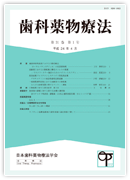All issues

Volume 29 (2010)
- Issue 3 Pages 97-
- Issue 2 Pages 61-
- Issue 1 Pages 1-
Volume 29, Issue 2
Displaying 1-4 of 4 articles from this issue
- |<
- <
- 1
- >
- >|
Original Articles
-
SHOKO KATO, KYOKO HARADA, KIYOSHI DAITO, MASAHARU TAKEYASU, MICHIHARU ...2010Volume 29Issue 2 Pages 61-68
Published: August 01, 2010
Released on J-STAGE: September 11, 2010
JOURNAL FREE ACCESSInflammation in dental pulp tissue is associated with tissue degradation, and matrix metalloproteinases (MMPs) are believed to participate in this destruction. Elevated levels of some MMPs have been reported in inflamed pulp and periapical lesions. Moreover, in inflamed pulp, many kinds of inflammatory cytokines such as interleukin (IL)-1β and tumor necrosis factor (TNF)-α, are released from inflammatory cells like macrophages, lymphocytes and neutrophils. In the present study, we examined whether TNF-α affected the production of MMP-2 in deciduous dental pulp fibroblasts and its signaling pathways utilizing gelatin zymography and western blotting analysis. TNF-α increased the expression of MMP-2 in a dose-dependent manner in deciduous dental pulp fibroblasts. U0126, which are MEK1/2 inhibitors, inhibited the MMP-2 production induced by TNF-α in deciduous dental pulp fibroblasts. Moreover, in deciduous dental pulp fibroblasts cultured with TNF-α, ERK1/2 was phosphorylated in a time-dependent manner with the maximum phosphorylation at 30 min, and U0126 abolished this phosphorylation of MEK1/2 in TNF-α-stimulated deciduous dental pulp fibroblasts. These results suggest that TNF-α may enhance pulp tissue destruction during pulp inflammation in part by regulating MMP-2, and that the MEK1/2-ERK1/2 pathway is involved in MMP-2 production in deciduous dental pulp fibroblasts.View full abstractDownload PDF (451K) -
RYO SEKIYA, KAZUNARI KARAKIDA, TOSHIHIRO ARAI, YUSUKE SATO, YUKI SAKAM ...2010Volume 29Issue 2 Pages 69-76
Published: August 01, 2010
Released on J-STAGE: September 11, 2010
JOURNAL FREE ACCESSThe biofilm formation ability of various bacteria and Candida species isolated from patients with odontogenic infections which were grown on a microtiter plate was evaluated by the crystal violet staining method. As a result, strains with a strong biofilm formation ability were detected in some isolates of Prevotella intermedia, Porphyromonas gingivalis, Actinomyces odontolyticus, Streptococcus mitis, Candida albicans and Candida glabrata.
The inhibitory effects of various antimicrobial agents or antifungal agents on biofilm formation of these isolates were investigated at subinhibitory concentrations (sub-MICs). The inhibitory effects of linezolid, azithromycin and clarithromycin on biofilm formation were obtained at the sub-MICs for P. intermedia and P. gingivalis, but not obtained at those for other bacterial species. On the other hand, the biofilm formation of C. albicans and C. glabrata was inhibited at the sub-MIC of micafungin.View full abstractDownload PDF (556K) -
YOSHIAKI KAMIKAWA, TETSUYA NITTA, TOMOHIRO NAGAYAMA, KIYOTSUGU KAWASAK ...2010Volume 29Issue 2 Pages 77-82
Published: August 01, 2010
Released on J-STAGE: September 11, 2010
JOURNAL FREE ACCESSThere are few available methods to evaluate the minor salivary gland secretory function. Murata reported a valid method but requires a long time to make the test paper and must also be newly produced for every examination.
Objectives: The aim of this study is to develop an improved test paper (ITP) to evaluate the minor salivary gland function in order to reduce the drying time and improve the quality and stability of the text results.
Methods: Filter paper was equally soaked with 3% iodine ethanol solution and with 25% starch and ethanol solution. Thereafter, 5, 10, 15 and 20 μL of artificial saliva were dropped onto ITP and all spots changed to a dark brownish hue and then were read by a scanner and finally were converted into gray scale and measured by an image analysis software program. The coefficient correlation color changed areas according to the dropped volume on the ITP were then statistically examined.
Results: This new ITP dried easily, namely within 1 h. Five, 10, 15 and 20 μL of Saliveht® were dropped on 10 pieces of ITP and all spots changed to a dark brownish hue. All pieces of ITP, both used and unused, were then stored in a dark and dry desiccator for 12 months and then color changes were observed thereafter. The average color changed areas showed significant correlation with the known dropped volumes onto the ITP.
Significance: ITP reduced the drying time, and increased the quality and stability of the findings.View full abstractDownload PDF (294K)
Clinical Report
-
HIDETOMO NISHIKAWA, KOH-ICHI NAKASHIRO, HIROYUKI HAMAKAWA2010Volume 29Issue 2 Pages 83-90
Published: August 01, 2010
Released on J-STAGE: September 11, 2010
JOURNAL FREE ACCESSSodium dodecyl sulfate (SDS), synthetic detergent is included in commercial dentifrice. SDS has protein denaturation action, and it is noxious for oral mucosa. Ecol dental herbyTM is a dentifrice manufactured from only natural plant materials without noxious compound. We evaluated the efficacy of Ecol dental herbyTM in 80 patients with xerostomia, glossodynia or dysgeusia. As a result, it had no effect on saliva flow rate, subjective and objective symptom of xerostomia and dysgeusia in use of 3 months. However, the pain of glossodynia was significantly improved. In addition, the adverse event was not found all over the periods of use at all. These results suggest that Ecol dental herbyTM might be effective for glossodynia.View full abstractDownload PDF (305K)
- |<
- <
- 1
- >
- >|